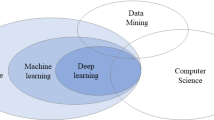Abstract
This study aims to design a back-propagation artificial neural network (BP-ANN) to estimate the reliable porosity values from the well log data taken from Kansas gas field in the USA. In order to estimate the porosity, a neural network approach is applied, which uses as input sonic, density and resistivity log data, which are known to affect the porosity. This network easily sets up a relationship between the input data and the output parameters without having prior knowledge of petrophysical properties, such as porefluid type or matrix material type. The results obtained from the empirical relationship are compared with those from the neural network and a good correlation is observed. Thus, the ANN technique could be used to predict the porosity from other well log data.
Similar content being viewed by others
References
Al-Qahtani F.A., 2000. Porosity Distribution Prediction Using Artificial Neural Networks. MSc Thesis, Morgantown Virginia University, West Virginia.
Aminian K. and Ameri S., 2005. Application of artificial neural networks for reservoir characterization with limited data. J. Petrol. Sci. Eng., 49, 212–222.
Arabani M.S. and Bidhendi M., 2002. Porosity prediction from wireline logs using artificial neural networks: a case study in north-east of Iran. Iranian Int. J. Sci., 3, 221–233.
Baan M. and Jutten C., 2000. Neural networks in geophysical applications. Geophysics, 65, 1032–1047.
Bhatt A. and Helle H.B., 2002. Committee neural networks for porosity and permeability prediction from well logs. Geophys. Prospect., 50, 645–660.
Dorrington K.P. and Link C.A., 2004. Genetic-algorithm/neural-network approach to seismic attribute selection for well-log prediction. Geophysics, 69, 212–221.
Gastaldi C., Biguenet J. and Pazzis L.D., 1997. Reservoir characterization from seismic attributes: an example from the Peciko field (Indonesia). Leading Edge, 16, 263–266.
Hearst J.R., Nelson P.H. and Paillet F.L., 2000. Well Logging for Physical Properties. John Wiley and Sons Ltd., New York.
Helle H.B., Bhatt A. and Ursin B., 2001. Porosity and permeability prediction from wireline logs using artificial neural networks: a North Sea case study. Geophys. Prospect., 49, 431–444.
Hampson D.P., Schuelke J.S. and Quierin J.A., 2001. Use of multiattribute transforms to predict log properties from seismic data. Geophysics, 66, 220–236.
Iturrarán-Viveros U. and Parra J.O., 2014. Artificial neural networks applied to estimate permeability, porosity and intrinsic attenuation using seismic attributes and well-log data. J. Appl. Geophys., 107, 45–54.
Kaydani H., Mohebbi A. and Baghaie A., 2012. Neural fuzzy system development for the prediction of permeability from wireline data based on fuzzy clustering. Petrol. Sci. Technol., 30, 2036–2045.
Latta F.B., 1944. Geology and Ground-Water Resources of Finney and Gray Counties, Kansas. Kansas Geological Survey Bulletin 55 (http://www.kgs.ku.edu/General/Geology/Finney/index.html).
Nikravesh M. and Aminzadeh F., 2001. Past, present and future intelligent reservoir characterization trends. J. Petrol. Sci. Eng., 31, 67–79.
Nikravesh M., Aminzadeh F. and Zadeh L.A., 2003. Soft Computing and Intelligent Data Analysis in Oil Exploration. Developments in Petroleum Sciences 51. Elsevier, Amsterdam, The Netherlands.
Ouenes A., 2000. Practical application of fuzzy logic and neural networks to fractured reservoir characterization. Comput. Geosci., 26, 953–962.
Pramanik A.G., Singh V., Vig R., Srivastava A.K. and Tiwary D.N., 2004. Estimation of effective porosity using geostatistics and multiattribute transforms: a case study. Geophysics, 69, 352–372.
Russell B., Hampson D., Schuelke J. and Quirein J., 1997. Multiattribute seismic analysis. Leading Edge, 16, 1439–1443.
Russell B.H. 2004. The Application of Multivariate Statistics and Neural Networks to the Prediction of Reservoir Parameters Using Seismic Attributes. PhD Thesis, University of Calgary, Calgary, Alberta, Canada.
Serra O. 1984a. Formation density measurements (the gamma-gamma log or density log). In: Serra O. (Ed.), Fundamentals of well-log interpretation. Developments in Petroleum Sciences 15A. Elsevier, Amsterdam, The Netherlands, 195–204.
Serra O. 1984b. The measurement of resistivity. In: Serra O. (Ed.), Fundamentals of well-log interpretation. Developments in Petroleum Sciences 15A. Elsevier, Amsterdam, The Netherlands, 51–76.
Taner M., 1995. Neural networks and computation of neural network weights and biases by the generalized delta rule and back-propagation of errors. Rock Solid Images (http://www.rocksolidimages.com/pdf/neural_network.pdf).
Wackerly D. and Scheaffer W., 2008. Mathematical Statistics with Applications. 7th Edition. Thomson Brooks/Cole, Duxbury, MA.
Wong P.M. and Nikravesh M., 2001. Introduction: field applications of intelligent computing techniques. J. Petrol. Geol., 24, 381–387.
Wyllie M.R.J., Gregory A.R. and Gardner L.W., 1956. Elastic wave velocities in heterogeneous and porous media. Geophysics, 21, 41–70.
Author information
Authors and Affiliations
Corresponding author
Rights and permissions
About this article
Cite this article
Singh, S., Kanli, A.I. & Sevgen, S. A general approach for porosity estimation using artificial neural network method: a case study from Kansas gas field. Stud Geophys Geod 60, 130–140 (2016). https://doi.org/10.1007/s11200-015-0820-2
Received:
Revised:
Accepted:
Published:
Issue Date:
DOI: https://doi.org/10.1007/s11200-015-0820-2




